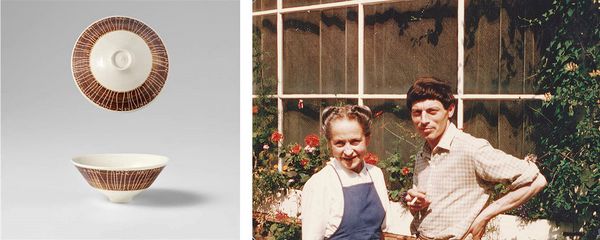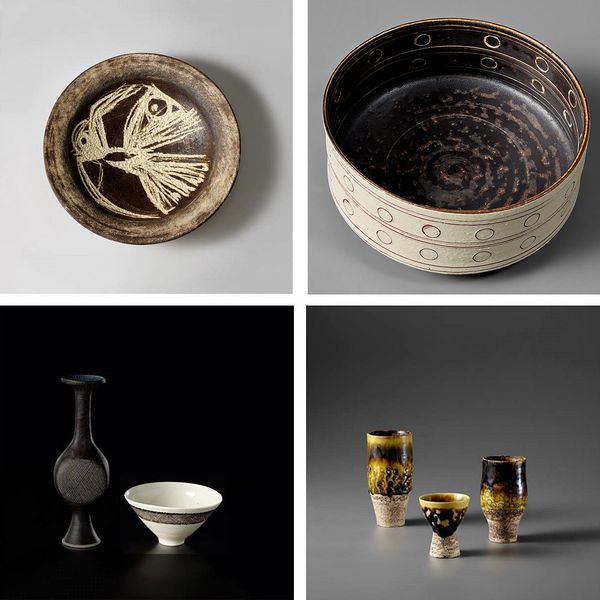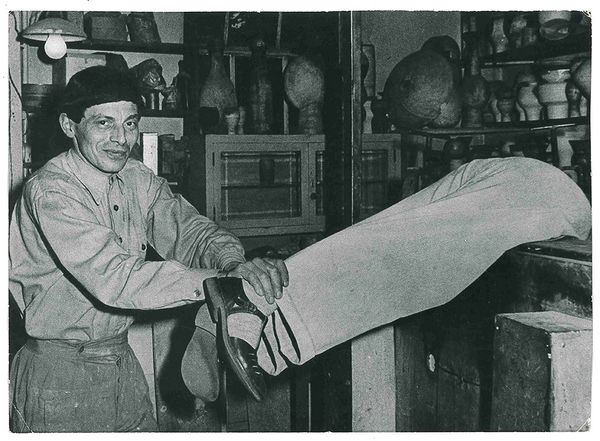Lucie Rie working in her studio in Vienna, summer, 1930. © Estate of Lucie Rie. From the Crafts Study Centre, University for the Creative Arts, 2005.40.
Here, Eliza Spindel, Co-editor of Lucie Rie: The Adventure of Pottery (2023) explores Lucie Rie’s astonishing career and her fortuitous meeting with Hans Coper, with whom she would form a deep and abiding, lifelong creative friendship. Both are featured in Phillips' much-anticipated 1 November 2023 ceramics auction in London — Lucie Rie and Hans Coper, Exceptional Ceramics: Selections from the Estate of Jane Coper and the former Collection of Cyril Frankel. View catalog.
Lucie Rie never planned to be a potter. Aged twenty, she had enrolled at the Vienna Kunstgewerbeschule, the progressive school of arts and crafts linked to the Wiener Werkstätte. Having joined with the intention of studying sculpture, Rie quickly discovered the potter’s wheel and was, in her own words, “lost to the wheel.” After dedicating her student years to mastering wheel throwing and glaze chemistry, Rie set up a small studio in central Vienna, garnering a small but dedicated following as well as critical acclaim. The pots Rie made in Vienna during the 1930s reflect this enduring fascination with the rhythm and life of the wheel, and the alchemy of glazing and firing. She had quickly distinguished herself from her contemporaries, rejecting the fashion for decorative and figurative ceramics, and instead producing simple, often cylindrical vessels, their forms animated by subtle throwing rings and unusual textured glazes (Lot 369 Lucie Rie Vienna period lidded jar).
Formative influences are visible in these important early pieces. The clarity and rigor of continental Modernism can be seen in their clean lines and crisp geometry, as well as the absence of decoration and interest in the inherent qualities of clay, slip, and glaze – whether unglazed clay (Lot 327 Lucie Rie Vienna period cup and saucer) or richly variegated glazes (Lot 326 Lucie Rie Vienna period small ‘jardinière’). Rie was also fascinated by ancient ceramics, in particular the Roman pots excavated on her uncle’s vineyard, whose ‘floating’ poise had left an enduring impression on her as a child. In an early experiment, Rie made a tea service from unglazed red earthenware which she burnished to a glossy sheen, mimicking Roman samian ware. A shallow cup and saucer from the set, with its streamlined form and looped handle, manages to recall both Bauhaus geometry and an ancient Roman oil lamp. This synthesis of ancient and modern would emerge as one of the defining characteristics of Rie’s work.
(Left) Lot 327 Lucie Rie Vienna period cup and saucer and (Right) Lot 326 Lucie Rie Vienna period small ‘jardinière.' Lucie Rie and Hans Coper, Exceptional Ceramics.
In 1938, Rie’s life and career were turned upside down, with the annexation of Austria by Nazi Germany and the persecution of Jewish people that immediately followed. That October, Rie made the journey from Vienna to London. She took with her a small number of pots in her suitcase, carefully wrapped in clothing for protection. Arriving in London, Rie found a supportive network of fellow Jewish refugees and émigrés, including the artist and glass designer Fritz Lampl. When war broke out, and Rie was unable to secure the necessary permit to sell her pots, Lampl offered her work in his glass workshop, Bimini, producing glass buttons. Rie soon began making her own clay designs, and later shifted production to her small mews studio in Paddington after the Bimini workshop was bombed.
A far cry from her Viennese pots, the buttons nevertheless reflect Rie’s innovation and imagination, even under the most inauspicious circumstances (Lot 315 Lucie Rie 29 buttons and brooches). Their forms are playful, glazed in an array of bright colors and metallic lusters, designed to enliven drab 1940s utility fashion. They also represent a crucial chapter in Rie’s development as a potter: she was often required to match glazes to a fabric swatch, equipping her with a masterful understanding of glaze chemistry.
(Left) Lot 315 Lucie Rie 29 buttons and brooches, (Right) Lot 316 Lucie Rie Bowl and Lot 317 Lucie Rie Oval bowl. Lucie Rie and Hans Coper, Exceptional Ceramics.
Rie did continue to make small numbers of pots alongside the buttons. Two small, jewel-like blue bowls (Lot 316 Lucie Rie Bowl and Lot 317 Lucie Rie Oval bowl), one unusually stamped with the Bimini seal, represent rare examples of pots made during this period, and demonstrate the fluidity with which Rie shifted between making buttons and making pots.
The button workshop also instigated one of the most important relationships of Rie’s life and career. Hans Coper arrived at Rie’s studio in 1946 to join the small group of assistants employed to help with button production. Coper was a fellow Jewish refugee who had fled Germany for Britain, only to be interned as an enemy alien upon the outbreak of war. Eighteen years her junior, and without any training in ceramics, Rie nonetheless recognized the young German’s talent. The two potters began to work side by side, making independent work as well as collaborating on ranges of stylish tableware stamped with both potters’ initials. A small bowl by Rie bears the sgraffito inscription: ‘FOR HANS COPER CHRISTMAS 1949 FROM HIS BOSS LUCIE RIE ALL DEBTS CANCELLED’ (Lot 314 Lucie Rie ‘All debts cancelled’ bowl). Beneath Rie’s characteristically dry wit, the dedication poignantly attests to the closeness of their friendship, and the depth of support and encouragement. Rie had offered Coper a lifeline, while Coper in turn became Rie’s most trusted confidant, who she credited with giving her confidence and encouragement to work against the grain of British studio pottery trends.
(Left) Lot 314 Lucie Rie ‘All debts cancelled’ bowl. Lucie Rie and Hans Coper, Exceptional Ceramics. (Right) Lucie Rie and Hans Coper outside 18 Albion Mews, summer 1956. From the Crafts Study Centre, University for the Creative Arts, RIE/20/2/9.
Pots made by Rie and Coper during these years reflect a flowing exchange of ideas and techniques. Most significant was their use of sgraffito, a technique discovered on a joint trip to Avebury, where they encountered Bronze Age bowls decorated with etched linear patterns. On early pots by Coper, designs resembling birds and fish are cut energetically through a deep brown manganese glaze (Lot 307 Hans Coper Large dish). In Rie’s hands, sgraffito takes on a precise, graphic sensibility, with fine parallel lines recalling the grids and circles of her mentor, Josef ‘Quadratl’ Hoffman (Lot 325 Lucie Rie Small conical bowl). Rie developed a technique for using the metal ferrule of a paintbrush to achieve perfect sgraffito and inlaid circles (Lot 335 Lucie Rie Bowl). A rare group of early vases by Coper uses the same technique to different effect, the circles rising organically like bubbles beneath a flowing manganese glaze (Lot 333 Hans Coper Three early vases).
(Left–Right) Lot 307 Hans Coper Large dish, Lot 335 Lucie Rie Bowl, Lot 325 Lucie Rie Small conical bowl, Lot 333 Hans Coper Three early vases. Lucie Rie and Hans Coper, Exceptional Ceramics.
Coper eventually left the studio in 1958 to focus on his independent work, ending a twelve-year collaboration that profoundly shaped both potters’ careers, as well as transforming the landscape of British postwar studio pottery.
Hans Coper holding Lucie Rie’s legs while she unpacks the top-loading kiln at Albion Mews, c.1950. From the Crafts Study Centre, University for the Creative Arts, 2005.40.
Discover More from Design, London >
Recommended Reading
Incisions into Space: Hans Coper's Cycladic Pots >
The Personal Pots: The Jane Coper and Cyril Frankel Collections >





